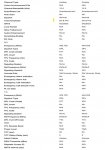A quick expansion of my previous comments about DPL codes: The ones that have aliases all have identical pulse trains. (Identical to another code that it aliases to. Such as, for hypothetical examples, 113, 272, and 407.) It's just a matter of where the train starts and stops. The DPL decoder doesn't KNOW where it's supposed to start and stop. So if it sees the right pulse train, ANYWHERE in the data, then it opens squelch.
Whether the train is 1001111100110110 (repeat) or 0011111001101101(repeat) or 1101001111100110(repeat) they all look the same to the DPL decoder. That's why they alias. Those trains I just wrote are just representational, and are NOT in the actual DPL signalling format. Just to be cler about that.
There are no sync bits. That's the issue that allows aliasing.
From Genave.com:
Digital Coded Squelch
DCS is also known as Motorola Digital Private Line – “DPL “
DCS is a digital form of
CTCSS. Instead of sending a continuous audio tone however, it transmits a low level digital signal.
DCS sends a fixed octal digit 4 as the first digit, followed by the three octal digits shown in the table
The code words are 23 bit long strings. 12 bits of octal code followed by 11 bits of CRC. This makes a total of 23 bits sent in a Golay encoded words. There are no sync bits and the baud rate is 134.4. Each bit is 7.5 msec in length, for a total of 172.5 msec. Although it looks like there should be 512 codes available, there are only 83 possibilities. This is to prevent a codeword that is misaligned as it is serially shifted into the decoder, matching one of the other codes.


